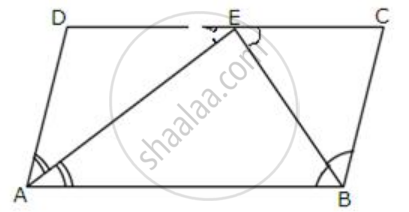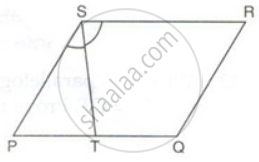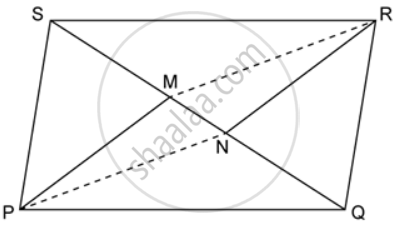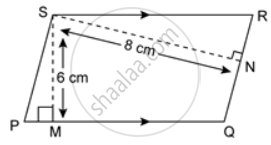Advertisements
Advertisements
प्रश्न
In the given figure, ABCD is a parallelogram.
Prove that: AB = 2 BC.

उत्तर
Given ABCD is a parallelogram
To prove: AB = 2BC

Proof: ABCD is a parallelogram
A + D + B + C = 180°
From the AEB we have
⇒ `("∠A")/(2) + ("∠B")/(2)` + E = 180°
⇒ ∠A - `("∠A")/(2)` + ∠D + ∠E1 = 180° ...[taking E1 as new angle]
⇒ ∠A + ∠D + ∠E1 = 180° + `("∠A")/(2)`
⇒ ∠E1 = `("∠A")/(2)` ...[Since ∠A + ∠D = 180°]
Again,
similarly,
∠E1 = `("∠B")/(2)`
Now
AB = DE + EC
= AD + BC
= BC + BC
= 2BC ...[since AD = BC]
Hence, proved.
APPEARS IN
संबंधित प्रश्न
E is the mid-point of side AB and F is the mid-point of side DC of parallelogram ABCD. Prove that AEFD is a parallelogram.
The diagonal BD of a parallelogram ABCD bisects angles B and D. Prove that ABCD is a rhombus.
In the alongside diagram, ABCD is a parallelogram in which AP bisects angle A and BQ bisects angle B.

Prove that:
- AQ = BP
- PQ = CD
- ABPQ is a parallelogram.
In parallelogram ABCD, the bisector of angle A meets DC at P and AB = 2 AD.
Prove that:
(i) BP bisects angle B.
(ii) Angle APB = 90o.
PQRS is a parallelogram. T is the mid-point of PQ and ST bisects ∠PSR.
Prove that: ∠RTS = 90°
In the given figure, MP is the bisector of ∠P and RN is the bisector of ∠R of parallelogram PQRS. Prove that PMRN is a parallelogram.
In a parallelogram ABCD, E is the midpoint of AB and DE bisects angle D. Prove that: BC = BE.
In a parallelogram ABCD, E is the midpoint of AB and DE bisects angle D. Prove that:CE is the bisector of angle C and angle DEC is a right angle
In the given figure, the perimeter of parallelogram PQRS is 42 cm. Find the lengths of PQ and PS.
In parallelogram ABCD of the accompanying diagram, line DP is drawn bisecting BC at N and meeting AB (extended) at P. From vertex C, line CQ is drawn bisecting side AD at M and meeting AB (extended) at Q. Lines DP and CQ meet at O. Show that the area of triangle QPO is `9/8` of the area of the parallelogram ABCD
